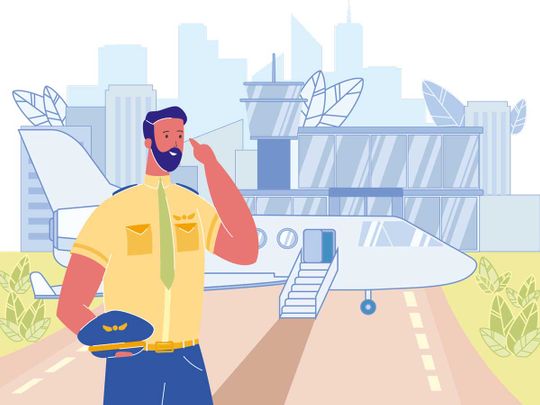
One morning this spring, I drove past the quiet municipal airport in Pittsfield, Massachusetts. I couldn’t stop myself from slowing down and smiling as I looked out on the place where, nearly 30 years ago, I first got airborne as a pilot.
I remember strapping my 16-year-old self into the small aircraft, which seemed so tinny and even improvised — qualities that suggested lightness but that also reminded me of my Swedish uncle’s terrifying, Soviet-era Lada car. I was struck, too, by the heat in the plane’s greenhouselike cockpit, and by the jarring noise of its engine as it caught, which too closely resembled that of the unreliable lawnmower I’d spent recent summers pushing. Soon we were accelerating down the runway. Reaching the correct speed, I carefully moved the control column backward as the instructor had taught me to. The resulting leap transformed the hometown I thought I knew into an almost unbroken surface of undulating treetops. It was magnificent.
Now, my take-offs are from places far from Pittsfield in every sense: London, Tokyo, Hyderabad, Chennai, Jeddah and others. But when I walk out of a glittering terminal into the different air of one of these vast cities, I often think back to the times, long before my first flying lesson, when my mum or dad would drive me up to the chain-link fence around Pittsfield’s airport. We’d sit inside the car in winter, or on top of a picnic table in summer, and eat doughnuts while we watched the planes come and go. And here’s the thing: I never thought about landing back then. Take-off was all I wanted.
It’s not surprising that the desire for take-off comes first, whether to a kid or to civilisation itself. Many of the loveliest descriptions of take-off date from aviation’s early days. Or they look back to when flight was only a dream. The poet Anne Sexton asked us to Consider Icarus, pasting those sticky wings on, testing that strange little tug at his shoulder blade, / and think of that first flawless moment. Our knowledge of later moments, Sexton suggests, shouldn’t detract from a fine beginning.
On my final trip as a 747 pilot, the captain offered me the choice of flying the outbound leg from London to Cape Town, including the landing there, or the leg home...I didn’t hesitate to opt for the landing there instead. An arrival was somehow the perfect farewell.
Then there’s Isak Dinesen, one of my favourite writers on flying. Born in 1885, her generation was among the last to grow up in a world without aeroplanes. Dinesen described her early experiences of flight in the book that was later adapted into the film Out of Africa. Of take-offs, she wrote: “Every time that I have gone up in an airplane and looking down have realised that I was free of the ground, I have had the consciousness of a great new discovery. ‘I see’; I have thought, ‘This was the idea.’” No one, I think, has said it better.
Every air traveller will have a perspective on take-offs and landings. And which do most prefer? To find out, I recently put together an admittedly unscientific poll on Twitter. More than 900 travellers responded, of whom a majority, 59 per cent, preferred take-offs. Many added comments that surely would have pleased Dinesen. It’s “the anticipation and getting a first look at the world from above,” wrote one respondent. Others described take-off as “a promise”; “the start of something”; and a “joyful leaving-behind.” (And what, I’d like to know, would the aristocratic Dinesen have made of this comment: “My guilty pleasure is listening to Danger Zone as the pilot hits the throttle.”)
In contrast, 41 per cent of respondents preferred landings. Several cited their (accurate) impression that pilots descend through the last few thousand feet of air more slowly than we climb up through it after take-off. One preferred landings because of the “gradual” pace of descent, as the “destination slowly comes into view and things get bigger and bigger.” The measured pace of descent, wrote another traveller, “lets me get a good look at the region. Especially if it’s a place I know well, I love seeing it from above.”
If those who prefer landings are a minority, it’s one that likely includes most pilots. I recently consulted more than a dozen professional pilots. All strongly preferred landings, including Mark Feuerstein, a retired test pilot who captained the first flights of two recent versions of the 747. “Oh, landings win out,” Feuerstein told me. They’re “more challenging. There’s a lot going on in a short period of time.” (His wife, an airline pilot, agrees that landings get “top billing.”)
Why do landings typically ask more of a pilot? One simplified way to put it is that the sky is big and a runway is less so. Imagine a narrow space in a parking lot and how much easier it is to drive out of it, especially in one continuous manoeuvre, than it is to navigate in. Or — while it’s not the complete picture, either — you might think of landings as a progressive application of constraints, as we move from three dimensions of motion in the open sky, to the confines of more or less one permitted dimension as we roll down the runway’s centreline after touchdown.
Feuerstein added that “pilots tend to remember landings, in general, longer than take-offs.” The challenges, and the professional satisfaction of safely completing a flight, are among the main reasons. But there are other factors, too. Many pilots enjoy exploring as much as any traveller might, and take-offs, of course, are inevitably from a city to which we’ve already been. And while take-offs offer a particularly pure sense of beginning, a landing is a beginning, too — one that can be full of anticipation for the new world we’ll soon be walking through.
I recently flew to Islamabad, the surprisingly verdant capital of Pakistan. It was my first touchdown in the country after many years of regularly overflying it. The experience of watching an impressionistic landscape, one that I’d previously seen only tens of thousands of feet below me, steadily resolve into the fine detail of towers, lakes, buses on wide highways and so many Pakistani trees — into the “world that still stands as / the trundling tyres keep shaking and shaking the heart,” as the Nobel laureate Derek Walcott put it — remains the greatest wonder of my job.
Strangely, perhaps, landings even take precedence for me when it’s time to say goodbye to a city. Last year, on my final trip as a 747 pilot, the captain offered me the choice of flying the outbound leg from London to Cape Town, including the landing there, or the leg home, a few days later, which would start with take-off from Cape Town. But, while a take-off from Cape Town would have made for the more obvious goodbye to that beloved metropolis, I didn’t hesitate to opt for the landing there instead. An arrival was somehow the perfect farewell.
The old pilot joke about take-offs and landings — that you want the same number of each — hints at another reason landings have become more meaningful to me. One of the less appreciated pleasures of the pilot’s job is its neatness (for lack of a better term). Unlike in the business world I worked in previously, there are no long meetings, tabled proposals or months-long roll-outs. Each flight is a discreet task, one that will always be circumscribed by flight-time regulations, the capacity of fuel tanks or — ultimately — the size of the earth.
One consequence of this way in which a pilot’s work is so neatly contained is that each flight starts to echo everything else that has an obvious beginning, middle and end. And as I fly through middle age, that’s an increasingly lovely thing. I want to tell my family and friends about it all: how the trees, and much else, were suddenly below me, and how that sight reminded me of the years when that was all I wanted.
But the difference between the 16-year-old who got airborne from Pittsfield and the 45-year-old who touched down in Islamabad is that somewhere along the way I’ve acquired an unexpected love of wholeness. And it’s landings, even the ones in the farthest-off cities, that again and again complete a simple story: I went up and away, and it was marvellous, and then it was time to come home.
Mark Vanhoenacker is a British Airways pilot, a columnist for The Financial Times and the author of How to Land a Plane and Skyfaring.











